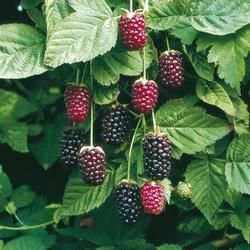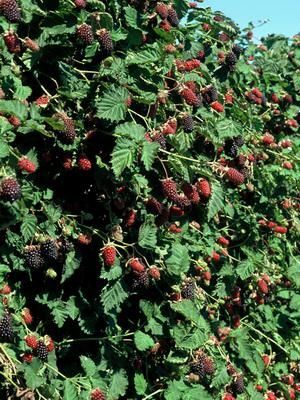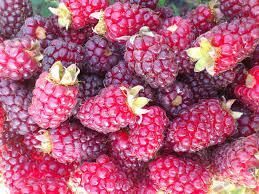 The Boysen berry on our tables is still a very rare visitor, as this fruit has the origin of a hybrid and was produced by crossing blackberries and raspberries. You can find out about it on the pages of Internet sites and periodicals, but most of the information is near-scientific, and it is related more with the origin of the berry itself than with the presentation of its useful properties.
The Boysen berry on our tables is still a very rare visitor, as this fruit has the origin of a hybrid and was produced by crossing blackberries and raspberries. You can find out about it on the pages of Internet sites and periodicals, but most of the information is near-scientific, and it is related more with the origin of the berry itself than with the presentation of its useful properties.
In some sources, this berry was named Loganova, but this is fundamentally not true. Since Judge Logan himself, who was the first to accidentally bring out a hybrid of these two sweet berries, by the time of establishment of a separate species - has already died. And this means that it was already impossible for him to appropriate the honor of the discovery and give his offspring a name. The name "Boysenova berry" was introduced into Russian by breeder Michurin, who had a certain passion for all sorts of vegetable curiosities. At the moment, this bush is increasingly called a simple phrase - "Ezhemalina", it is not entirely true, but it reflects the very essence of its origin.
Variety features of the bosene berry
Grow it so rare that it is almost impossible to meet a boyzene berry on the territory of our country, breeders-lovers are not enough even in its historical homeland, in the US state of California. In large farming and horticultural companies, it also has not gained wide popularity, because it is quite problematic to collect berries from a bush. The plant is densely covered with leaves, there are thorns on the stems and young sprouts, and the crop itself ripens unevenly. And this means that it is impossible to collect it all in a few days. For some reason, most consumers are of the opinion that this berry is not as useful and tasty as raspberries and blackberries individually.
And yet, this berry has certain advantages, if you compare it with raspberries and blackberries. It is resistant to frost and ripens very late: the fruits can be removed from the end of August and until November, when on the street there are stable, though minimal frosts. In addition, the boyzenova berry is very productive - one adult bush allows you to get up to eight kilograms of ripe berries in one season. The fruit itself is quite large, sometimes the parrots have to be tied to pergolas and arches, otherwise they will just break down under the weight of ripe berries. This method of growing also greatly simplifies the process of harvesting fruits. The ripe fruit looks shiny, has a purple color and has a blackberry taste and aroma.
Caloric content and vitamin composition of the bosene berry

Fruits are not very high in calories, only 55 kcal per 100 grams of fresh product. And in the fruit juice can be noted the following useful elements:
- Potassium;
- Calcium;
- Phosphorus;
- Magnesium;
- Sodium;
- The vitamins of groups A, B, C, K, PP and E.
The berry is not only very tasty and juicy, it is also very useful if you include it in the diet in the form of fresh fruits.
Usefulness of jemaline
It contains a lot of fiber, so eating fruits contributes to the improvement of peristalsis and on the whole normalizes the work of the gastrointestinal tract. Berries are a means of preventing constipation, can improve eyesight, strengthen the cardiovascular system, increase immunity, act as a calorie and therefore are needed to strengthen the nail plate, hair bulbs and bones. Alcoholic infusion with bozenovoy berry is used in the treatment of sleep disorders, insomnia, to eliminate symptoms of chronic fatigue and constant stress.
Important: there are no categorical contraindications to use. The only caveat - people with frequent food allergies are advised before using the berries to find out if they have an individual intolerance to the product.
How to use the berry in the
cooking The berry can be frozen and canned, after which it can be served as a natural dessert, regardless of the season. From fresh berries prepare tasty jam, compote, jams, alcoholic and non-alcoholic cocktails.
Important: with any method of preparation, the berries will not only be tasty, but also very useful. The chemical composition of the juice is rich in fructose, glucose, sucrose, ascorbic acid, carotene, tocopherol, nicotinic acid. Each fruit contains pectins, tannins, a group of bioflavonoids, acids: apple, lemon, salicylic and wine.

The constant use of berries in food is the prevention of the development of cancer cells, apparently enhances the protective function of the immune system, strengthens the vessels and capillaries. All this is due to the high content of anthocyanins, flavonols, leucoanthocyanins, catechins and phenolic compounds.
Fresh fruits can have an anti-inflammatory effect. Of it is necessary to eat with respiratory diseases, pneumonia, fevers, and in the case when it is necessary to lower the temperature of the body. Boysenova berry soothingly acts on the crises of the nervous system and normalizes digestion. Homeopaths are often recommended to consume the fruits of this plant with cystitis, inflammation of the kidneys and joints, toxic poisoning, especially alcoholic vapors and heavy metals.
Some recipes use not only the berry itself, but also the aerial part of the plant - young branches and green foliage.
